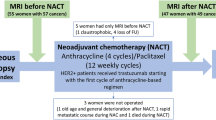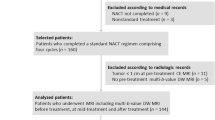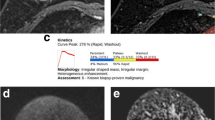Abstract
Objectives
To investigate possible associations between quantitative apparent diffusion coefficient (ADC) metrics derived from whole-lesion histogram analysis and breast cancer recurrence risk in women with estrogen receptor (ER)–positive, human epidermal growth factor receptor 2 (HER2)–negative, node-negative breast cancer who underwent the Oncotype DX assay.
Methods
This retrospective study was conducted on 105 women (median age, 48 years) with ER-positive, HER2-negative, node-negative breast cancer who underwent the Oncotype DX test and preoperative diffusion-weighted imaging (DWI). Histogram analysis of pixel-based ADC data of whole tumors was performed, and various ADC histogram parameters (mean, 5th, 25th, 50th, 75th, and 95th percentiles of ADCs) were extracted. The ADC difference value (defined as the difference between the 5th and 95th percentiles of ADCs) was calculated to assess intratumoral heterogeneity. Associations between quantitative ADC metrics and the recurrence risk, stratified using the Oncotype DX recurrence score (RS), were evaluated.
Results
Whole-lesion histogram analysis showed that the ADC difference value was different between the low-risk recurrence (RS < 18) and the non-low-risk recurrence (RS ≥ 18; intermediate to high risk of recurrence) groups (0.600 × 10−3 mm2/s vs. 0.746 × 10−3 mm2/s, p < 0.001). Multivariate regression analysis demonstrated that a lower ADC difference value (< 0.559 × 10−3 mm2/s; odds ratio [OR] = 5.998; p = 0.007) and a small tumor size (≤ 2 cm; OR = 3.866; p = 0.012) were associated with a low risk of recurrence after adjusting for clinicopathological factors.
Conclusions
The ADC difference value derived from whole-lesion histogram analysis might serve as a quantitative DWI biomarker of the recurrence risk in women with ER-positive, HER2-negative, node-negative invasive breast cancer.
Key Points
• A lower ADC difference value and a small tumor size were associated with a low risk of recurrence of breast cancer.
• The ADC difference value could be a quantitative marker for intratumoral heterogeneity.
• Whole-lesion histogram analysis of the ADC could be helpful for discriminating the low-risk from non-low-risk recurrence groups.


Similar content being viewed by others
Abbreviations
- ADC:
-
Apparent diffusion coefficient
- ASCO:
-
American Society for Clinical Oncology
- BRCA:
-
Breast cancer susceptibility gene
- CI:
-
Confidence interval
- DCE:
-
Dynamic contrast-enhanced
- DWI:
-
Diffusion-weighted imaging
- ER:
-
Estrogen receptor
- HER2:
-
Human epidermal growth factor receptor 2
- MRI:
-
Magnetic resonance imaging
- NCCN:
-
National Comprehensive Cancer Network
- OR:
-
Odds ratio
- PR:
-
Progesterone receptor
- ROI:
-
Region-of-interest
- RS:
-
Recurrence score
References
Paik S, Shak S, Tang G et al (2004) A multigene assay to predict recurrence of tamoxifen-treated, node-negative breast cancer. N Engl J Med 351:2817–2826
Paik S, Tang G, Shak S et al (2006) Gene expression and benefit of chemotherapy in women with node-negative, estrogen receptor-positive breast cancer. J Clin Oncol 24:3726–3734
Schneider JG, Khalil DN (2012) Why does Oncotype DX recurrence score reduce adjuvant chemotherapy use? Breast Cancer Res Treat 134:1125–1132
Hassett MJ, Silver SM, Hughes ME et al (2012) Adoption of gene expression profile testing and association with use of chemotherapy among women with breast cancer. J Clin Oncol 30:2218–2226
Harris LN, Ismaila N, McShane LM et al (2016) Use of biomarkers to guide decisions on adjuvant systemic therapy for women with early-stage invasive breast cancer: American society of clinical oncology clinical practice guideline. J Clin Oncol 34:1134–1150
Henry NL, Somerfield MR, Abramson VG et al (2016) Role of patient and disease factors in adjuvant systemic therapy decision making for early-stage, operable breast cancer: American society of clinical oncology endorsement of cancer care Ontario guideline recommendations. J Clin Oncol 34:2303–2311
Dialani V, Gaur S, Mehta TS et al (2016) Prediction of low versus high recurrence scores in estrogen receptor–positive, lymph node–negative invasive breast cancer on the basis of radiologic-pathologic features: comparison with Oncotype DX test recurrence scores. Radiology 280:370–378
Li H, Zhu Y, Burnside ES et al (2016) MR imaging radiomics signatures for predicting the risk of breast cancer recurrence as given by research versions of MammaPrint, Oncotype DX, and PAM50 gene assays. Radiology 281:382–391
Thakur SB, Durando M, Milans S et al (2018) Apparent diffusion coefficient in estrogen receptor-positive and lymph node–negative invasive breast cancers at 3.0 T DW-MRI: a potential predictor for an Oncotype Dx test recurrence score. J Magn Reson Imaging 47:401–409
Amornsiripanitch N, Nguyen VT, Rahbar H et al (2018) Diffusion-weighted MRI characteristics associated with prognostic pathological factors and recurrence risk in invasive ER /HER2-breast cancers. J Magn Reson Imaging 48:226–236
Guo Y, Cai YQ, Cai ZL et al (2002) Differentiation of clinically benign and malignant breast lesions using diffusion-weighted imaging. J Magn Reson Imaging 16:172–178
Hirano M, Satake H, Ishigaki S, Ikeda M, Kawai H, Naganawa S (2012) Diffusion-weighted imaging of breast masses: comparison of diagnostic performance using various apparent diffusion coefficient parameters. AJR Am J Roentgenol 198:717–722
Razek AA, Gaballa G, Denewer A, Nada N (2010) Invasive ductal carcinoma: correlation of apparent diffusion coefficient value with pathological prognostic factors. NMR Biomed 23:619–623
Kim JY, Seo HB, Park S et al (2015) Early-stage invasive ductal carcinoma: association of tumor apparent diffusion coefficient values with axillary lymph node metastasis. Eur J Radiol 84:2137–2143
Choi Y, Kim SH, Youn IK, Kang BJ, Park W, Lee A (2017) Rim sign and histogram analysis of apparent diffusion coefficient values on diffusion-weighted MRI in triple-negative breast cancer: comparison with ER-positive subtype. PLoS One 12:e0177903
Kim EJ, Kim SH, Park GE et al (2015) Histogram analysis of apparent diffusion coefficient at 3.0 T: correlation with prognostic factors and subtypes of invasive ductal carcinoma. J Magn Reson Imaging 42:1666–1678
Kim JY, Kim JJ, Lee JW et al (2019) Risk stratification of ductal carcinoma in situ using whole-lesion histogram analysis of the apparent diffusion coefficient. Eur Radiol 29:485–493
Lewin R, Sulkes A, Shochat T et al (2016) Oncotype-DX recurrence score distribution in breast cancer patients with BRCA1/2 mutations. Breast Cancer Res Treat 157:511–516
Grady L (2006) Random walks for image segmentation. IEEE Trans Pattern Anal Mach Intell 28:1768–1783
Allred DC, Harvey JM, Berardo M, Clark GM (1998) Prognostic and predictive factors in breast cancer by immunohistochemical analysis. Mod Pathol 11:155–168
Moeder CB, Giltnane JM, Harigopal M et al (2007) Quantitative justification of the change from 10% to 30% for human epidermal growth factor receptor 2 scoring in the American society of clinical oncology/college of American pathologists guidelines: tumor heterogeneity in breast cancer and its implications for tissue microarray–based assessment of outcome. J Clin Oncol 25:5418–5425
Sparano JA, Gray RJ, Makower DF et al (2015) Prospective validation of a 21-gene expression assay in breast cancer. N Engl J Med 373:2005–2014
Kwee RM, Dik AK, Sosef MN et al (2014) Interobserver reproducibility of diffusion-weighted MRI in monitoring tumor response to neoadjuvant therapy in esophageal cancer. PLoS One 9:e92211
Bonekamp D, Bonekamp S, Halappa VG et al (2014) Interobserver agreement of semi-automated and manual measurements of functional MRI metrics of treatment response in hepatocellular carcinoma. Eur J Radiol 83:487–489
Yang Z, Tang LH, Klimstra DS (2011) Effect of tumor heterogeneity on the assessment of Ki67 labeling index in well-differentiated neuroendocrine tumors metastatic to the liver: implications for prognostic stratification. Am J Surg Pathol 35:853–860
Höckel M, Knoop C, Schlenger K et al (1993) Intratumoral pO2 predicts survival in advanced cancer of the uterine cervix. Radiother Oncol 26:45–50
Hockel M, Schlenger K, Aral B, Mitze M, Schaffer U, Vaupel P (1996) Association between tumor hypoxia and malignant progression in advanced cancer of the uterine cervix. Cancer Res 56:4509–4515
Kim JH, Ko ES, Lim Y et al (2017) Breast cancer heterogeneity: MR imaging texture analysis and survival outcomes. Radiology 282:665–675
Kim JY, Kim JJ, Hwangbo L, Kang T, Park H (2019) Diffusion-weighted MRI of invasive breast cancer: relationship to distant metastasis-free survival. Radiology 291:300–307
Funding
This study was supported by Biomedical Research Institute Grant (2018B036), Pusan National University Hospital.
Author information
Authors and Affiliations
Corresponding author
Ethics declarations
Guarantor
The scientific guarantor of this publication is Jin You Kim.
Conflict of interest
This work was based on the Multiparametric Analysis works-in-progress software package provided by Siemens Healthineers.
Statistics and biometry
No complex statistical methods were necessary for this paper.
Informed consent
Written informed consent was waived by the Institutional Review Board.
Ethical approval
Institutional Review Board approval was obtained.
Methodology
• Retrospective
• Observational
• Performed at one institution
Additional information
Publisher’s note
Springer Nature remains neutral with regard to jurisdictional claims in published maps and institutional affiliations.
Rights and permissions
About this article
Cite this article
Kim, J.Y., Kim, J.J., Hwangbo, L. et al. Diffusion-weighted MRI of estrogen receptor-positive, HER2-negative, node-negative breast cancer: association between intratumoral heterogeneity and recurrence risk. Eur Radiol 30, 66–76 (2020). https://doi.org/10.1007/s00330-019-06383-6
Received:
Revised:
Accepted:
Published:
Issue Date:
DOI: https://doi.org/10.1007/s00330-019-06383-6




